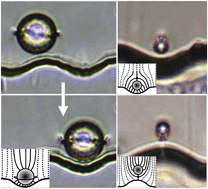Experimental realization of the “lock-and-key” mechanism in liquid crystals†
Abstract
The ability to control the movement and assembly of particles in liquid crystals is not only an important route to design functional materials, but also sheds light on the mechanisms of colloidal interactions. In this study we place micron-sized particles with “Saturn ring” defects near a wall with hills and dales that impose perpendicular (homeotropic) molecular anchoring. The strong splay distortion at the wall interacts with the distortion around the particles in the near field and favors their migration towards the dales via the so-called “lock-and-key” mechanism. We demonstrate experimentally that the lock-and-key mechanism can robustly localize a particle at specific topographical features. We observe the complex trajectories traced by the particles as they dock on the dales, estimate the binding energy, and explore a range of parameters that favor or disfavor the docking event, thus exploiting the capabilities of our experimental system. We extend the study to colloids with homeotropic anchoring but with an associated point defect instead of a Saturn ring and show that they find a different preferred location, i.e. we can place otherwise identical particles at well defined sites according to their topological defect structure. Finally, for deep enough wells, confinement drives topological transitions of Saturn rings to dipoles. This ability to tailor wall geometry to guide colloids to well defined sites within nematic liquid crystals represents an important new tool in directed assembly.


 Please wait while we load your content...
Please wait while we load your content...